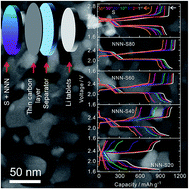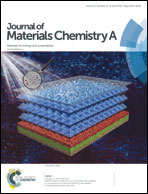Coordination effect of network NiO nanosheet and a carbon layer on the cathode side in constructing a high-performance lithium–sulfur battery†
Abstract
Effectively preventing polysulfides from dissolving during the discharge/charge process to improve the performance of a lithium–sulfur battery is one of the essential requirements for commercialization. An NiO sheet with a network structure was developed via a simple two-step method and used as a mediator for a lithium–sulfur battery coupled with a carbon layer on the cathode side. Specifically, by introducing a thin carbon layer on the cathode side of the separator the dissolution of polysulfides was effectively hindered, and moreover the rate capability and long-term stability were effectively enhanced by the further addition of network NiO nanosheets owing to their mesoporous channels and the NiO–S interaction. Besides, in comparison with the cell performance at different S loadings, the cathode with 80 wt% of S in the total electrode exhibited a high specific capacity and excellent rate performance up to 5C. In addition, although the redox potential range of NiO did not form part of the recharging potential window, NiO exhibited an obvious interaction with polysulfides and limited their tendency to dissolve. The present study demonstrates that the joint action of network NiO and the carbon layer presents great potential to be used in low-cost and high-energy lithium–sulfur batteries and provides important guidance for the design of a multifunctional sulfur host for the battery cathodes.



 Please wait while we load your content...
Please wait while we load your content...